The Night Sky April 2014
Compiled by Ian Morison
This page, updated monthly, will let you know some of the things that you can look out for in the night sky. It lists the phases of the Moon, where you will see the naked-eye planets and describes some of the prominent constellations in the night sky during the month.
Image of the Month
BICEP2 CMB results
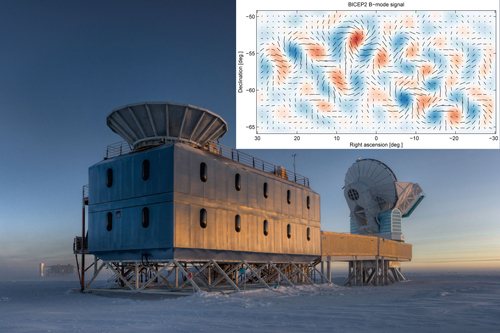
BICEP2 CMB Polarization Results .
Image: BICEP2 Collaboration, NSF, Stephan Richer (Harvard)
One prediction of the theories relating to the Big Bang origin of the Universe and the inflation that vastly increased its size, is that the tiny quantum fluctuations present prior to the inflationary phase would have become far greater in extent and would have launched gravitational waves travelling through space. As these waves distorted space as they passed through, they would have had the effect of slightly polarizing the light so giving rise to a "curling" pattern in the polarized orientation of light in the ancient Universe. If this is true, then this imprint should still be visible in the microwave radiation that makes up the cosmic microwave background (CMB).
As the amount of polarization was predicted to be very small its detection is exceedingly difficult but finally, in March 2014, the scientists using an experiment called BICEP2 located at the South Pole (where it is so cold that water vapour is frozen out of the atmosphere and microwave radiation can pass through un-attenuated) announced that they detected the predicted curling pattern of polarization in the CMB.
If this result is confirmed then it is proof of an inflationary phase in the early Universe, gives a further indirect detection of gravitational waves and, perhaps most importantly, that gravity had to be quantized. Could a Nobel Prize be in the offing?
Highlights of the Month
April - Mars at Opposition.
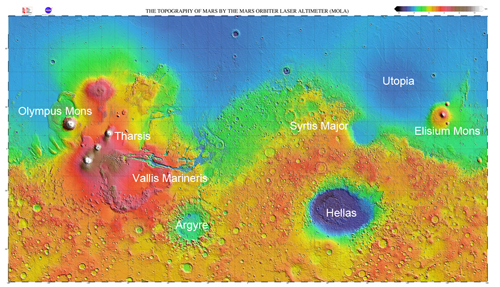
Image NASA.
Mars, lying above Spica in Virgo, reaches opposition on April 8th when its magnitude will be -1.5 and its angular diameter 15.1 arc seconds. Due to the fact that Mars, and to a lesser extend, the Earth have elliptical orbits, its distance from us at opposition can vary from ~54 to 102 million km. As a result the angular size will vary from ~13 to 25 arc seconds - a major difference. The angular size at opposition is now increasing to reach 18.6 arc seconds in May 2016 and 24.31 arc seconds in July 2018. Sadly,this year, Mars' elevation when on the meridian will only be ~30 degrees, so the atmosphere will limit our view somewhat but given a night of good seeing and a small telescope the planet's main features should be seen such as the north polar cap and Syrtis Major - a triangular shaped dark region.
April - it is still worthwhile to view Jupiter.
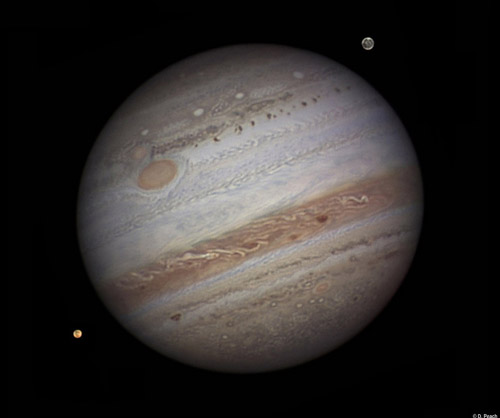
Jupiter imaged by Damian Peach
Jupiter is now well past opposition but this is a still a good month to observe this giant of planets. It now lies Gemini and so is high in the ecliptic and hence, when due south, at an elevation of ~60 degrees and is high in the sky in the early evening. Though Jupiter's angular size falls from ~42 down to ~38 arc seconds throughout the month, a small telescope can see lots of details - surely one should be on your shopping list if you do not have one! It is looking somewhat different than in the last few years as the north equatorial belt has become quite broad. The Great Red Spot has recently become more prominent and can be easily seen as a large feature in the South Equatorial Belt.
The features seen in the Jovian atmosphere have been changing quite significantly over the last few years - for a while the South Equatorial Belt vanished completely (as seen in Damian's image) but has now returned to its normal wide state. The diagram on right shows the main Jovian features as imaged by the author at the beginning of December 2012. The highlight below gives the times when the GRS is facing us.
The image by Damian Peach was taken with a 14 inch telescope in Barbados where the seeing can be particularly good. This image won the "Astronomy Photographer of the Year" competition in 2011.
See more of Damian Peach's images: Damian Peaches Website"
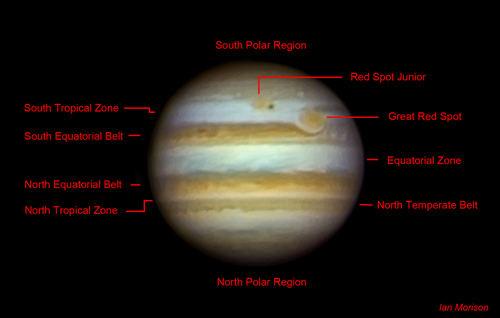
Features in Jupiter's atmosphere - December 2013.
April: Look for the Great Red Spot on Jupiter
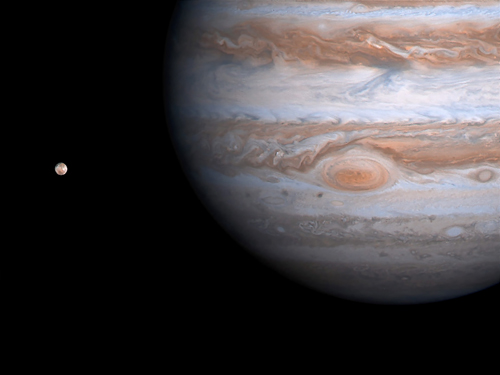
Observe the Great Red Spot
Image: NASA
This list gives some of the best evening times (in UT) during April to observe the Great Red Spot which should then lie on the central meridian of the planet.
1st 22:44 23rd 21:01
4th 20:14 25th 22:40
6th 21:53 30th 21:50
11th 21:03
13th 22:42
16th 20:12
18th 21:51
April : Spot two asteroids, Ceres and Vesta, close in the heavens.
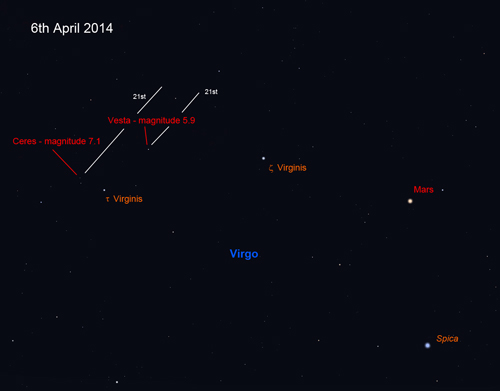
Vesta and Ceres
Image: Stellarium/IM
Two of the brightest asteroids come to opposition this month: Vesta, shining at (an unusually bright) magnitude 5.8, on April 13th and Ceres, at magnitude 7.0, two days later. Throughout April they remain 2.5 degrees apart so could both be seen in a single field of view of a pair of binoculars. They lie up to the left of Spica in Virgo, and the chart shows their joint positions around the time of opposition, April 5th to 21st. In one sence, despite its small size of 356 x 346 x 277 miles, Vesta could almost qualify as a planet in that it has become differentiated with an iron core overlain by a middle density mantle and light crustal rock surface. As a result, the term "planetoid" is being applied to Vesta. Ceres is nearly twice as large and gravity has rounded its ~ 585 mile (940 km) diameter shape. As its diameter exceeds 800 km and has a spherical shape, it is now classified as a "dwarf planet" like Pluto. Later this year, on July 5th, they will be just 10 arc minutes apart in the sky.
April 14th - after sunset: Mars less than 5 degrees from the nearly full Moon
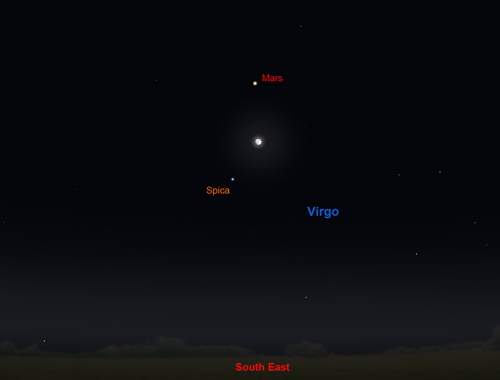
Mars and the Moon
Image: Stellarium/IM
Looking southeast around after sunset on the evening of the 14th, Mars, in Virgo, will be seen just less than five degrees above the Moon just one day before full. At the same time, the Moon will be just over four degrees above Spica making a nice tight grouping in the sky.
April 26th - before dawn: Venus and the thin crescent Moon.
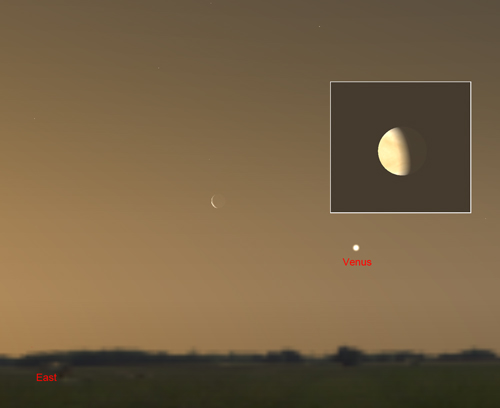
Saturn and the Moon
Image: Stellarium/IM
Looking south south-east before dawn on the morning of the 26th, Venus, at magnitude -4.1 lying in Pisces, will be seen just less than six degrees to the right of a thin crescent waning Moon.
April 9th: Two Great Lunar Craters
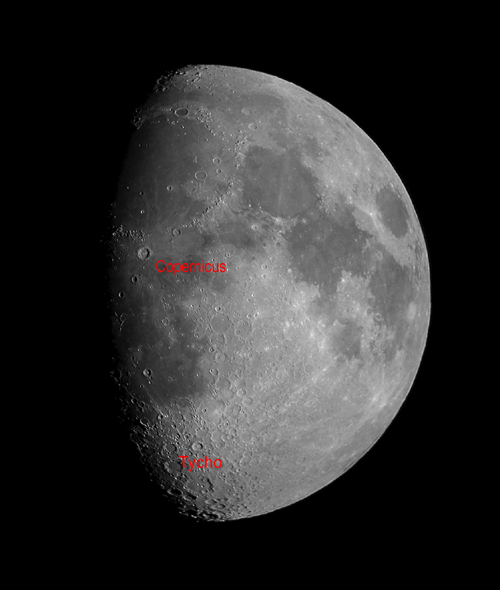
Tycho and Copernicus: IM.
Two great Lunar Craters: Tycho and Copernicus
This is a great night to observe two of the greatest craters on the Moon, Tycho and Copernicus, as the terminator is nearby. Tycho is towards the bottom of Moon in a densely cratered area called the Southern Lunar Highlands. It is a relatively young crater which is about 108 million years old. It is interesting in that it is thought to have been formed by the impact of one of the remnents of an asteroid that gave rise to the asteroid Baptistina. Another asteroid originating from the same breakup may well have caused the Chicxulub crater 65 million years ago. It has a diameter of 85 km and is nearly 5 km deep. At full Moon - seen in the image below - the rays of material that were ejected when it was formed can be see arcing across the surface. Copernicus is about 800 million years old and lies in the eastern Oceanus Procellarum beyond the end of the Apennine Mountains. It is 93 km wide and nearly 4 km deep and is a clasic "terraced" crater. Both can be seen with binoculars.
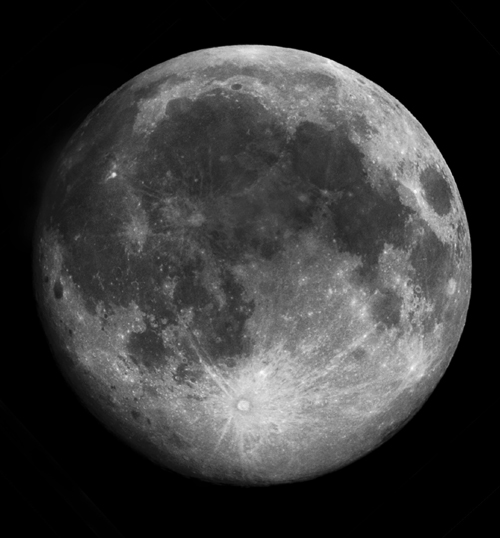
Full Moon showing Tycho's rays: IM
A Messier Object imaged with the Faulkes Telescope: Messier 27 - The Dumbell Nebula
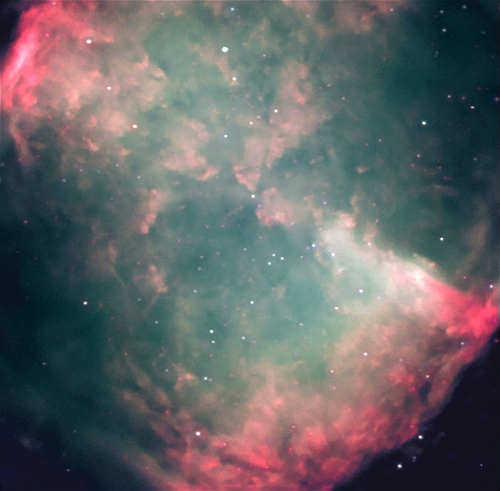
The Dumbell Nebula
Image:Nik Szymanik
Faulkes Telescope North.
The Dumbell Nebula, imaged by Nik Szymanek.
This image was taken using the Faulkes Telescope North by Nik Szymanek - one of the UK's leading astro-photograpers. M27 is a planetary nebula, the result of a "nova" expolsion at the end of the life of a star like our Sun. The core at the centre of the star collapes under gravity until it is about the size of the Earth when "electron degeneracy pressure", resulting from the fact that electrons do not like being squashed too close together, prevents further collapse. This is called a "white dwarf". As the dying ember of a nuclear fusion reactor, they are exceedingly hot, but will gradually cool over time. The outer parts of the star are expelled at high speed into space resulting in the (in this case) spherical nebula surrounding the white dwarf. The field of the view of the CCD array on the Faulkes Telesocpe is a little too small to encompass the whole nebula. Once, with a 16 inch telescope under perfect conditions, I visually observed M27 and its central part appeared a vivid iridescent green - the only time I have ever seen colour in a deep sky object!
Learn more about the Faulkes Telescopes and how schools can use them: Faulkes Telescope"
Observe the International Space Station

The International Space Station and Jules Verne passing behind the Lovell Telescope on April 1st 2008.
Image by Andrew Greenwood
Use the link below to find when the space station will be visible in the next few days. In general, the space station can be seen either in the hour or so before dawn or the hour or so after sunset - this is because it is dark and yet the Sun is not too far below the horizon so that it can light up the space station. As the orbit only just gets up the the latitude of the UK it will usually be seen to the south, and is only visible for a minute or so at each sighting. Note that as it is in low-earth orbit the sighting details vary quite considerably across the UK. The NASA website linked to below gives details for several cities in the UK. (Across the world too for foreign visitors to this web page.)
Note: I observed the ISS three times recently and was amazed as to how bright it has become.
Find details of sighting possibilities from your location from: Location Index
See where the space station is now: Current Position
The Moon
 The Moon at 3rd Quarter. Image, by Ian Morison, taken with a 150mm Maksutov-Newtonian and Canon G7.
The Moon at 3rd Quarter. Image, by Ian Morison, taken with a 150mm Maksutov-Newtonian and Canon G7.
Just below the crator Plato seen near the top of the image is the mountain "Mons Piton". It casts a long shadow across the maria from which one can calculate its height - about 6800ft or 2250m.
| new moon |
first quarter |
full moon |
last quarter |
`
| April 29th |
April 7th |
April 15th |
April 22nd |
Some Lunar Images by Ian Morison, Jodrell Bank Observatory: Lunar Images
A World Record Lunar Image
 The 9 day old Moon.
The 9 day old Moon.
To mark International Year of Astronomy, a team of British astronomers have made the largest lunar image in history and gained a place in the Guinness Book of Records! The whole image comprises 87.4 megapixels with a Moon diameter of 9550 pixels. This allows details as small as 1km across to be discerned! The superb quality of the image is shown by the detail below of Plato and the Alpine Valley. Craterlets are seen on the floor of Plato and the rille along the centre of the Alpine valley is clearly visible. The image quality is staggering! The team of Damian Peach, Pete lawrence, Dave Tyler, Bruce Kingsley, Nick Smith, Nick Howes, Trevor Little, David Mason, Mark and Lee Irvine with technical support from Ninian Boyle captured the video sequences from which 288 individual mozaic panes were produced. These were then stitched together to form the lunar image.
 Plato and the Alpine Valley.
Plato and the Alpine Valley.
Please follow the link to the Lunar World Record website and it would be really great if you could donate to Sir Patrick Moore's chosen charity to either download a full resolution image or purchase a print.
The Planets

A montage of the Solar System. JPL / Nasa
Jupiter is high in the south western sky at sunset as it nears the end of an excellent apparition whilst Mars is closest to us on April 14th.
Jupiter

A Cassini image of Jupiter . Nasa
Jupiter. This month Jupiter is a little past its best and should be viewed soon after night fall when it is closest to the meridian and so highest in the sky. Shining at magnitude -2.2 (falling to magnitude -2 during the month) it is visible for much of the evening. Its angular size is reducing as we move away, from 38 down to 35 arc seconds As April begins, Jupiter will be due south at about 8:30 pm. Jupiter is lying in the constellation Gemini and is now moving westwards away from the star Mebsuta, Epsilon Geminorum. With a small telescope you can observe the 4 Gallilean moons as they weave there way around it and, at times, be also able to pick out the Great Red Spot visible as an indentation of the South Equatorial belt.
See the highlights above.
Saturn

The planet Saturn. Cassini - Nasa
Saturn rises at about 10:30 (BST) at the start of the month and at about 8:30 pm at its end. Lying in Libra, it is shining with a magnitude of +0.1 by late April. Its disk has a diameter of 18.2 (increasing to 18.6) arc seconds. Saturn began its retrograde motion across the sky on March 6th so is now moving slowly westwards in Libra. The good news is that the rings (with a diameter of ~40 arc seconds) have now opened to around 22 degrees from the line of sight so presenting a magnificant view. With a small telescope one should be able to spot the Cassini Division that lies between the A and B rings when seeing conditions are good. Sadly for those of us in the northern hemisphere, Saturn is now lying in the more southerly part of the ecliptic so, even when due south does not get that high in the sky. Even worse, this will not improve for many years to come.
Mars

A Hubble Space Telescope image of Mars.
Jim Bell et al. AURA / STScI / Nasa
Mars, lying in Virgo, reaches opposition on April 8th, so is visible from dusk to dawn and is due south around 2am (BST) at the start of the month and ~11pm at its end. Its brightness reaches a maximum of magnitide -1.5 in the second week of the month - matching that of Sirius. Mars is actually closest to us on the 14th April whern its angular size reaches 15.16 arc seconds and it remains greater than 14.5 arc seconds throughout the remainder of the month. So now, given good seeing, it is possible to see markings on its salmon-pink surface (~91% illuminated) such as the polar caps and Syrtis Major. The north polar region is tilted towards us by ~19 degrees so the North Polar Cap should be particularly prominent. Mars is moving westwards in Virgo and, at the end of the month nears Porrima - Gamma Virginis - in its retrograde motion across the sky.
See the highlight above.
Mercury

Messenger image of Mercury Nasa
Mercury might just be spotted low above the horizon near sunrise at the beginning of the month but, as it passes through superior conjunction with the Sun on the 26th of April will not be visible for the remainder of the month. To be honest, not the best time to observe Mercury.
Venus

Venus showing some cloud structure
Venus. As April begins, Venus rises just before the onset of morning twilight but is still at less than 10 degrees elevation at sunrise. But, shining with a magnitude of -4.4, will still be easy to spot given a good low eastern horizon. During the month it moves nearer to the Sun, its magnitude drops to -4.2 whilst its angular diameter shrinks from 22 to 17 arc seconds. At the same time the illumination phase increases from 54% to 66% which is why its brightness does not drop that much.
See the highlight above.

Radar image showing surface features
The Stars
The mid evening April Sky
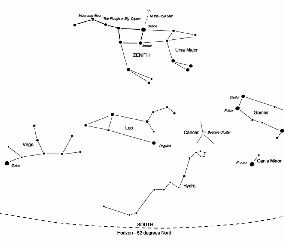
The April Sky in the south - mid evening.
This map shows the constellations seen in the south in mid-evening.
The constellation Gemini is now setting towards the south-west and Leo holds pride (sic) of place in the south with its bright star Regulus. Between Gemini and Leo lies Cancer. It is well worth observing with binoculars to see the Beehive Cluster at its heart. Below Gemini is the tiny constellation of Canis Minor whose only bright star is Procyon. Rising in the south-east is the constellation Virgo whose brightest star is Spica. Though Virgo has few bright stars it is in the direction of of a great cluster of galaxies - the Virgo Cluster - which lies at the centre of the supercluster of which our local group of galaxies is an outlying member. The constellation Ursa Major is high in the northern sky during the evening this month and contains many interesting objects.
The constellation Gemini
 Gemini - click on image to enlarge
Gemini - click on image to enlarge
Gemini - The Twins - lies up and to the left of Orion and is in the south-west during early evenings this month. It contains two bright stars Castor and Pollux of 1.9 and 1.1 magnitudes respectivly. Castor is a close double having a separation of ~ 3.6 arc seconds making it a fine test of the quality of a small telescope - providing the atmospheric seeing is good! In fact the Castor system has 6 stars - each of the two seen in the telescope is a double star, and there is a third, 9th magnitude, companion star 73 arcseconds away which is alos a double star! Pollux is a red giant star of spectral class K0. The planet Pluto was discovered close to delta Geminorum by Clyde Tombaugh in 1930. The variable star shown to the lower right of delta Geminorum is a Cepheid variable, changing its brightness from 3.6 to 4.2 magnitudes with a period of 10.15 days
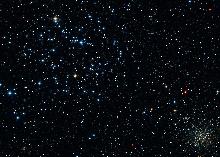 M35 and NGC 2158
M35 and NGC 2158
This wonderful image was taken by Fritz Benedict and David Chappell using a 30" telescope at McDonal Observatory. Randy Whited combined the three colour CCD images to make the picture
M35 is an open star cluster comprising several hundred stars around a hundred of which are brighter than magnitude 13 and so will be seen under dark skies with a relativly small telescope. It is easily spotted with binoculars close to the "foot" of the upper right twin. A small telescope at low power using a wide field eyepiece will show it at its best. Those using larger telescopes - say 8 to 10 inches - will spot a smaller compact cluster NGC 2158 close by. NGC 2158 is four times more distant that M35 and ten times older, so the hotter blue stars will have reached the end of their lives leaving only the longer-lived yellow stars like our Sun to dominate its light.
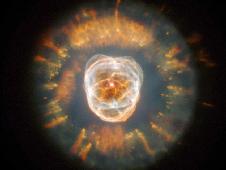 The Eskimo Nebula, NGC2392, Hubble Space Telescope
The Eskimo Nebula, NGC2392, Hubble Space Telescope
To the lower right of the constellation lies the Planetary Nebula NGC2392. As the Hubble Space Telescope image shows, it resembles a head surrounded by the fur collar of a parka hood - hence its other name The Eskimo Nebula. The white dwarf remnant is seen at the centre of the "head". The Nebula was discovered by William Herschel in 1787. It lies about 5000 light years away from us.
The constellation Leo
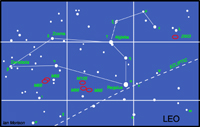 Leo - click on image to enlarge
Leo - click on image to enlarge
The constellation Leo is now in the south-eastern sky in the evening. One of the few constellations that genuinely resembles its name, it looks likes one of the Lions in Trafalger Square, with its main and head forming an arc (called the Sickle) to the upper right, with Regulus in the position of its right knee. Regulus is a blue-white star, five times bigger than the sun at a distance of 90 light years. It shines at magnitude 1.4. Algieba, which forms the base of the neck, is the second brightest star in Leo at magnitude 1.9. With a telescope it resolves into one of the most magnificent double stars in the sky - a pair of golden yellow stars! They orbit their common centre of gravity every 600 years. This lovely pair of orange giants are 170 light years away.
Leo also hosts two pairs of Messier galaxies which lie beneath its belly. The first pair lie about 9 degrees to the west of Regulus and comprise M95 (to the east) and M96. They are almost exactly at the same declination as Regulus so, using an equatorial mount, centre on Regulus, lock the declination axis and sweep towards the west 9 degrees. They are both close to 9th magnitude and may bee seen together with a telescope at low power or individually at higher powers. M65 is a type Sa spiral lying at a distance of 35 millin klight years and M66, considerably bigger than M65, is of type Sb. Type Sa spirals have large nuclei and very tightly wound spiral arms whilst as one moves through type Sb to Sc, the nucleus becomes smaller and the arms more open.
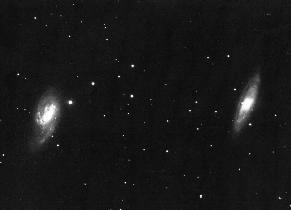 The galaxies M65 and M66
The galaxies M65 and M66
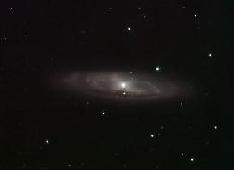
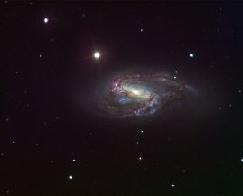 M65 - Type Sa spiral, 9.3 magnitude M66 - Type Sb spiral, 8.9 magnitude
M65 - Type Sa spiral, 9.3 magnitude M66 - Type Sb spiral, 8.9 magnitude
The second pair of galaxies, M95 and M96, lie a further 7 degrees to the west between the stars Upsilon and Iota Leonis. M95 is a barred spiral of type SBb. It lies at a distance of 38 million light years and is magnitude 9.7. M96, a type Sa galaxy, is slightly further away at 41 million light years, but a little brighter with a magnitude of 9.2. Both are members of the Leo I group of galaxies and are visible together with a telescope at low power.
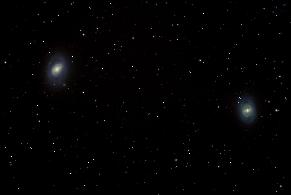 The galaxies M95 and M96
The galaxies M95 and M96
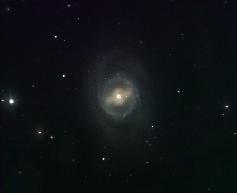
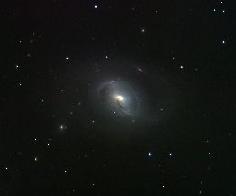 M95 - Type SBb spiral, 9.7 magnitude M96 - Type Sa spiral, 9.2 magnitude
M95 - Type SBb spiral, 9.7 magnitude M96 - Type Sa spiral, 9.2 magnitude
There is a further ~9th magnitude galaxy in Leo which, surprisingly, is in neither the Messier or Caldwell catalogues. It lies a little below lambda Leonis and was discovered by William Herschel. No 2903 in the New General Catalogue, it is a beautiful type Sb galaxy which is seen at somewhat of an oblique angle. It lies at a distance of 20.5 million light years.
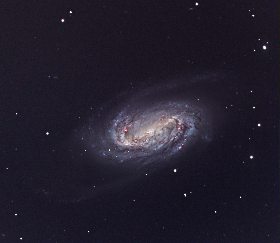 The 8.9th magnitude, type Sb, Galaxy NGC2903
The 8.9th magnitude, type Sb, Galaxy NGC2903
The constellation Virgo
 Virgo
Virgo
Virgo, rising in the east in late evening this month, is not one of the most prominent constellations, containing only one bright star, Spica, but is one of the largest and is very rewarding for those with "rich field" telescopes capable of seeing the many galaxies that lie within its boundaries. Spica is, in fact, an exceedingly close double star with the two B type stars orbiting each other every 4 days. Their total luminosity is 2000 times that of our Sun. In the upper right hand quadrant of Virgo lies the centre of the Virgo Cluster of galaxies. There are 13 galaxies in the Messier catalogue in this region, all of which can be seen with a small telescope. The brightest is the giant elliptical galaxy, M87, with a jet extending from its centre where there is almost certainly a massive black hole into which dust and gas are falling. This releases great amounts of energy which powers particles to reach speeds close to the speed of light forming the jet we see. M87 is also called VIRGO A as it is a very strong radio source.

 The Giant Elliptical Galaxy M87 HST image showing the jet
The Giant Elliptical Galaxy M87 HST image showing the jet
Below Porrima and to the right of Spica lies M104, an 8th magnitude spiral galaxy about 30 million light years away from us. Its spiral arms are edge on to us so in a small telescope it appears as an elliptical galaxy. It is also known as the Sombrero Galaxy as it looks like a wide brimmed hat in long exposure photographs.
 M104 - The Sombrero Galaxy
M104 - The Sombrero Galaxy
The constellation Ursa Major
 Ursa Major
Ursa Major
The stars of the Plough, shown linked by the thicker lines in the chart above, form one of the most recognised star patterns in the sky. Also called the Big Dipper, after the soup ladles used by farmer's wives in America to serve soup to the farm workers at lunchtime, it forms part of the Great Bear constellation - not quite so easy to make out! The stars Merak and Dubhe form the pointers which will lead you to the Pole Star, and hence find North. The stars Alcor and Mizar form a naked eye double which repays observation in a small telescope as Mizar is then shown to be an easily resolved double star. A fainter reddish star forms a triangle with Alcor and Mizar.
Ursa Major contains many interesting "deep sky" objects. The brightest, listed in Messier's Catalogue, are shown on the chart, but there are many fainter galaxies in the region too. In the upper right of the constellation are a pair of interacting galaxies M81 and M82 shown in the image below. M82 is undergoing a major burst of star formation and hence called a "starburst galaxy". They can be seen together using a low power eyepiece on a small telescope.
 M81 and M82
M81 and M82
Another, and very beautiful, galaxy is M101 which looks rather like a pinwheel firework, hence its other name the Pinwheel Galaxy. It was discovered in1781 and was a late entry to Messier's calalogue of nebulous objects. It is a type Sc spiral galaxy seen face on which is at a distance of about 24 million light years. Type Sc galaxies have a relativly small nucleus and open spiral arms. With an overall diameter of 170,000 light it is one of the largest spirals known (the Milky Way has a diameter of ~ 130,000 light years).
 M101 - The Ursa Major Pinwheel Galaxy
M101 - The Ursa Major Pinwheel Galaxy
Though just outside the constellation boundary, M51 lies close to Alkaid, the leftmost star of the Plough. Also called the Whirlpool Galaxy it is being deformed by the passage of the smaller galaxy on the left. This is now gravitationally captured by M51 and the two will eventually merge. M51 lies at a distance of about 37 million light years and was the first galaxy in which spiral arms were seen. It was discovered by Charles Messier in 1773 and the spiral structure was observed by Lord Rosse in 1845 using the 72" reflector at Birr Castle in Ireland - for many years the largest telescope in the world.
 M51 - The Whirlpool Galaxy
M51 - The Whirlpool Galaxy
Lying close to Merak is the planetary nebula M97 which is usually called the Owl Nebula due to its resemblance to an owl's face with two large eyes. It was first called this by Lord Rosse who drew it in 1848 - as shown in the image below right. Planetary nebulae ar the remnants of stars similar in size to our Sun. When all possible nuclear fusion processes are complete, the central core collpses down into a "white dwarf" star and the the outer parts of the star are blown off to form the surrounding nebula.

 M97 - The Owl Planetary Nebula Lord Rosse's 1848 drawing of the Owl Nebula
M97 - The Owl Planetary Nebula Lord Rosse's 1848 drawing of the Owl Nebula















































